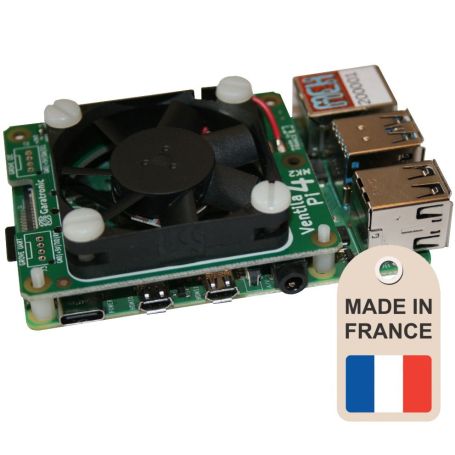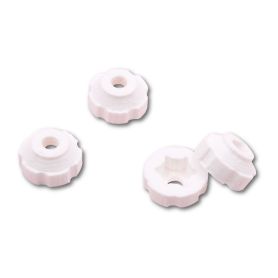Silent fan cooler for Raspberry-Pi
Fan for Raspberry-Pi
- MK2 revision (01/2021) - GPIO non accessible
- Silent... for real!
- Low consumption
- Low profile
- PWM driven (if needed)
- Grove connection points
Payments are secured by LyraCollect, a French payment collection company.
It is possible to delivered to your home, to a pick-up point or picked up by appointment at MCHobby
We prepare, pack and ship your orders with great respect and care.
VentilaPi4 - MK2 : offer a quiet cooler to your Raspberry-Pi, good for temperature and good for your ears
We all know, the Raspberry-Pi 3 and 4 heat... not really embarrassing since they can control their frequency to limit overheating to 85°C (it's the famous Throttling).
On the other hand, if we need a respondent, taking advantage of 100% of resources is important... so we must cool the Pi efficiently.
Thankfuly, VentilaPi4 from Garatronic demonstrate that they thinked a little more than our Chinese friends! Long live the French Tech!
What's up with this MK2 revision ?
This new revision (Jan. 2021) does bring the following improvments.
- As default behavior, the ventila-pi is still spinning as soon as the power is on
- However, you can control it via the GPIO12 (by soldering the JP3 jumper).
The control script can be inspired from the Raspberry-Pi foundation but with the GPIO12. - The new GPIO connector did lower the height of the whole board.
The total height if Pi+Ventila is now of 22.7mm !! - It now expose a GROVE UART connexion points directly wired to the Pi's GPIO.
- It also expose a GROVE I2C connexion points wired to the Pi's GPIO (The J1 & J2 jumper must be soldered to activate the pull-up resistors on the bus).
- The GROVE connectors can also be used to handle digital connexions with other Grove module.
One GROVE connector is included with the ventila-pi. You are free to solder it as you need it (on the UART or the I2C port). Warning, the connector is sensitive to over-heating (you will have to solder it fast). the Grove connectors are powered with 5V, the signals are 3.3V.
GPIO NOT AVAILABLE as the ventila-Pi is placed onto the GPIO. Using a stacking header allow you to retreives 4mm of the GPIO pin on the other side (but standard height is 6mm height).
Need for GPIO? you can still order the previous VentilaPi4 revision.
The errors of the competition
- So there is an universal rule, the smaller it is and the more it screams! The fans are no exceptions... the smaller they are and the more they make noise, unplaisant moreover with a range of frequency pulling in the treble. Our Chinese friends put all mini-fans but it isn't they who have to endure their hissing !
- No notion of fluid mechanics! If the air comes in, it must come out as freely as possible! A fan in a closed oven and well this makes a rotary oven.
- The air will always follow the path of least resistance... So in a closed case with an opening for the GPIO next to the fan is strictly useless. The air will exit immediately through the GPIO opening. The fan will not refresh much!
- Acrylic is a thermal insulator. Many cases propose to put the Pi4 in an acrylic case, placed directly on a plate of acrylic and a pseudo ventilation at the top. Guaranteed barbecue effect for Pi... It will cook from below!
How is the VentilaPi4 better?
- To begin, he is great! So it whistles less... uh not at all!
- Than, as it is larger, it can also turn more slowly (3000 rpm) while ensuring sufficient air flow to cool the Pi... So it is very silent.
- It's used without case... so no problems of fluidity and the whole board is refreshed.
- Garatronic propose booster feet to print (nut-holder feet, for free download). This allows to elevate the board and avoid the formation of a thermal cushion under the board.
- No maxi-super-large radiator... so no interference with the WiFi interface.
Garatronichas also tested the VentilaPi4 with a Pi4 in its case (the case base only). The temperature remains stable at ~52°C despite holding the 4 cores at 100% load for more than 30 minutes!
Tests and videos
The VentilaPi4 has of course been tested and offers efficient cooling while remaining remarkably quiet (noise barely noticeable) while ensuring more than 35000 hours of operation (+4 years).
Without active cooling, a Pi4 with open case easily mounts at 50~60°C off load (desktop display, room temp. 23°C).
The use of VentilaPi4 allows to return to 40°C after a few minutes (it is necessary to evacuate the heat accumulated in the board), almost 20°C less... temperature that will be maintained thanks to a sufficient air flow.
The consumption is 60 to 70mA at 5V with a maximum temperature of 40°C off load, 52°C full load (room temperature=23°C).
In stress test with 30 minutes of calculation on prime numbers (4 cores at 100%), the temperature is max 52°C without case (55°C with the official case, without cover).
Video
Recommendation
Here are some suggestions, from MC Hobby, for optimal cooling.
- Use the nut-holders offered for download by Garatronic. the underside of the board also needs air.
- Minimize, as much as possible, obstacles to the free flow of air.
- Don't use a case if this is possible (avoid creating an oven effect).
- When mounting VESA, place the GPIO down (warm air rises naturally, don't try to push it to "unnatural").
Content
For each order, you receive an assembled VentilaPi4, some screws and spacers are included (use them as needed). No welding operation needed for the ventilator (except for the Grove connector when needed) :-)
Raspberry-Pi not included. Nut-holders (feet to be printed) are not included but available for free download.
Ressources
The STL file of the nut-holders (recommended use) is available here.
If you are not able to print it, this product is also available for sale here.
Size for the VentilaPi
- PCB size: 56.5x65mm (Format HAT)
- Height: ~18.3mm
- Height Pi+Ventilator+Vis: 22.7mm
- Height of the nylon screw (ventila-pi4): 2.2mm


















